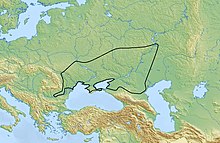
Back Cultura de les catacumbes Catalan Katakombengrab-Kultur German Cultura de las catacumbas Spanish Katakombikulttuuri Finnish Culture des catacombes French Cultura delle catacombe Italian Катакомба мәдениеті Kazakh Cultur de catacombas LFN Katakombų kultūra Lithuanian Catacombencultuur Dutch
 | |
| Geographical range | Pontic steppe |
|---|---|
| Period | Bronze Age |
| Dates | ca. 2500–1950 BC |
| Preceded by | Yamnaya culture |
| Followed by | Abashevo culture, Lola culture, Multi-cordoned ware culture, Srubnaya culture |
| Part of a series on |
| Indo-European topics |
|---|
 |
The Catacomb culture (Russian: Катакомбная культура, romanized: Katakombnaya kul'tura, Ukrainian: Катакомбна культура, romanized: Katakombna kul'tura) was a Bronze Age culture which flourished on the Pontic steppe in 2,500–1,950 BC.[1]
Originating on the southern steppe as an outgrowth of the Yamnaya culture, the Catacomb culture came to cover a large area. It was probably Indo-European-speaking, with some linguists associating it with Tocharian.[2] Influences of the Catacomb culture have been suggested to be found as far as Italy, Greece, and Syria.[3] It spawned the Multi-cordoned ware culture and was eventually succeeded by the Srubnaya culture.
- ^ Parpola, Asko, (2012). "Formation of the Indo-European and Uralic (Finno-Ugric) language families in the light of archaeology: Revised and integrated ‘total’ correlations", in Mémoires de la Société Finno-Ougrienne, Helsinki, p. 138.
- ^ Kroonen, Guus; Jakob, Anthony; Palmér, Axel I.; Sluis, Paulus van; Wigman, Andrew (12 October 2022). "Indo-European cereal terminology suggests a Northwest Pontic homeland for the core Indo-European languages". PLOS ONE. 17 (10): e0275744. Bibcode:2022PLoSO..1775744K. doi:10.1371/journal.pone.0275744. ISSN 1932-6203. PMC 9555676. PMID 36223379.
- ^ Mallory & Adams 1997, p. 92.
© MMXXIII Rich X Search. We shall prevail. All rights reserved. Rich X Search